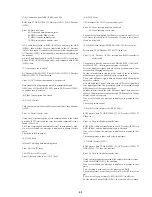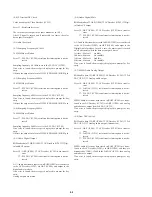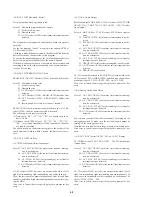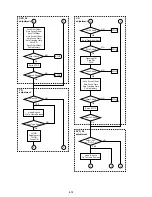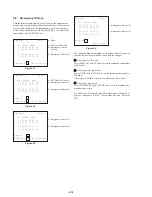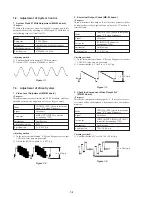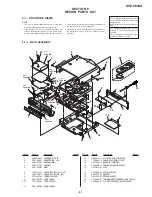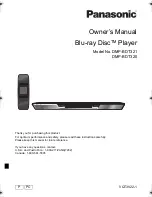
6-15
6-6-4. Manual Control 2
Manual Control 2
SA.000000
SI.00
EMG.00
0. Pause
off
4. Open
1. FCS. Srch
off
5. Close
3. Tilt_H
off
6. Chuck
7. Skip
DVD SL
12cm
Figure 14
Eject/Load are not usually used, because they can be done with
the [EJECT] button.
Chucking doesn't start automaticaly after “Close”. Close first then
press “Chuck”.
0. Pause
: Pause is made by executing track jump once per
revolution.
1. FCS.Srch : The focus drive system is checked by applying
same voltage to the focus drive as that in focus
search.
3. Tilt H
: Increase tilt gain.
4. Open
: Open
5. Close
: Closed and unchuck.
6. Chuck
: Chucking
7. Skip
: Skip from one disc to another. Perform on condi-
tion that discs are unchucked.
6-6-5. Manual Control 3
Manual Control 3
SA.000000
SI.00
EMG.00
0. FWD
32TJ
6. FT0
→
1
1. RVS
32TJ
7. FJ1
→
0
2. FWD
500TJ
8. LJ0
→
1
3. RVS
500TJ
9. LJ1
→
0
4. FWD
10KTJ
→
. FWD 1TJ
5. RVS
10KTJ
←
. RVS 1TJ
DVD SL
12cm
Figure 15
On this screen, track jump, etc. are executed.
Confirm the sector information (SI) to check the DVD_DL layer
jump direction. Even SI means layer 0, or odd SI means layer 1.
When 1TJ or 32TJ is executed, the tracking is turned on, but the
sled becomes just like initialization.
Also, after executing each jump except 1TJ (and FJ1, 2), the CLVA
mode is set.
The optical system will be damaged if make a jump in wrong di-
rection FJ0, FJ1, LJ0 and LJ1.
0. FWD 32TJ
: Jump 32 track forward (N track jump).
1. RVS 32TJ
: Jump 32 track reversely (N track jump).
2. FWD 500TJ : Jump 500 tracks forward (fine search).
3. RVS 500TJ
: Jump 500 tracks reversely (fine search).
4. FWD 10KTJ : Jump 10k tracks forward (direct search).
5. RVS 10KTJ : Jump 10k tracks reversely (direct search).
6. FJ0
→
1
: After layer jump L0
→
L1, tracking loop does not
turn on.
7. FJ1
→
0
: After layer jump L1
→
L0, tracking loop does not
turn on.
8. LJ0
→
1
: After layer jump L0
→
L1, tracking loop turns
on.
9. LJ1
→
0
: After layer jump L1
→
L0, tracking loop turns
on.
→
. FWD 1TJ
: Jump one track forward.
←
. RVS 1TJ
: Jump one track reversely.
6-6-6. Manual Adjust 1
Manual Adjust 1
SA.000000
SI.CD
EMG.00
0. TRK. Off set
xx
1. TRK. Off set 2 (DVD)
2. TRK. Gain 2 (CD)
3. Focus Gain
4. TRK. Gain
CD
12cm
Figure 16
On this screen, manual adjustment can be made where jitter mea-
surement is not executed.
0. TRK Offset
1
: Adjust tracking offset.
1. TRK. Offset 2 (DVD) : Adjust DVD tracking offset (TO SSI).
Adjusting range is (A1 – AF) with
A1 – A7: +25 to +175 mV,
A8 – AF: 0 to –175mV.
2. TRK Gain 2 (CD)
: Adjust simple AGC of CD.
Adjusting range is (88 ~ C8) with lower
4 bits fixed.
3. Focus Gain
: Adjust focus gain.
4. TRK Gain
2
: Adjust tracking gain.
1
TRK Off set : In the tracking offset adjustment for DVD, based
on the peak and bottom data measured by DSP, the
SSL33P3720A cansels the offset roughly, then the
DSP adjusts it finely.
Here, finely adjusted value is set. As adjustment is
made by DSP only.
DC component of tracking traverse does not
change.
For the CD, only this set value changes.
2
TRK Gain
: In the tracking gain adjustment for CD, based on
the peak and bottom data measured by DSP, the
CXA2556 on the sets simple AGC to 5 steps of
–3.2, –1.6, 0, +1.6, +3.2 dB (Auto Tracking Off-
set), then the DSP makes setting (Auto Tracking
Gain). Here, DSP setting canbe made. Inthe case
of DVD, only DSP setting is executed.
Summary of Contents for DVP-C600D - 5 Disc Cd/dvd Player
Page 10: ...1 1 SECTION 1 GENERAL This section is extracted from US model instruction manual DVP C600D ...
Page 11: ...1 2 ...
Page 12: ...1 3 ...
Page 13: ...1 4 ...
Page 14: ...1 5 ...
Page 15: ...1 6 ...
Page 16: ...1 7 ...
Page 17: ...1 8 ...
Page 18: ...1 9 ...
Page 19: ...1 10 ...
Page 20: ...1 11 ...
Page 21: ...1 12 ...
Page 22: ...1 13 1 13 E ...
Page 37: ...DVP C600D 4 3 4 4 FRAME 2 2 FRAME SCHEMATIC DIAGRAM 2 2 ...





